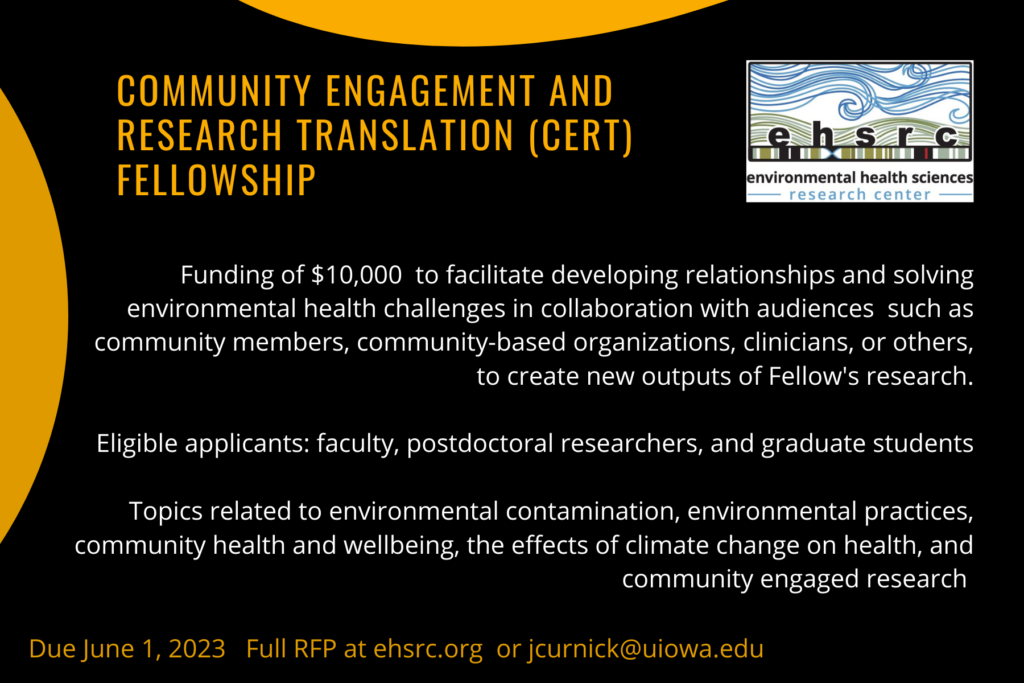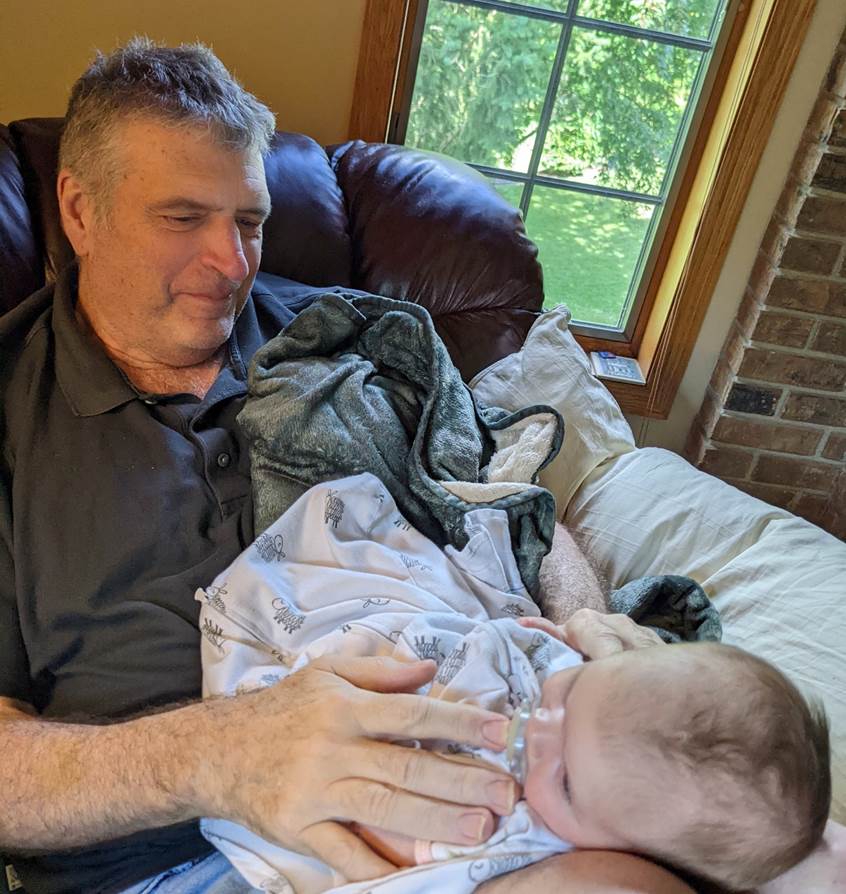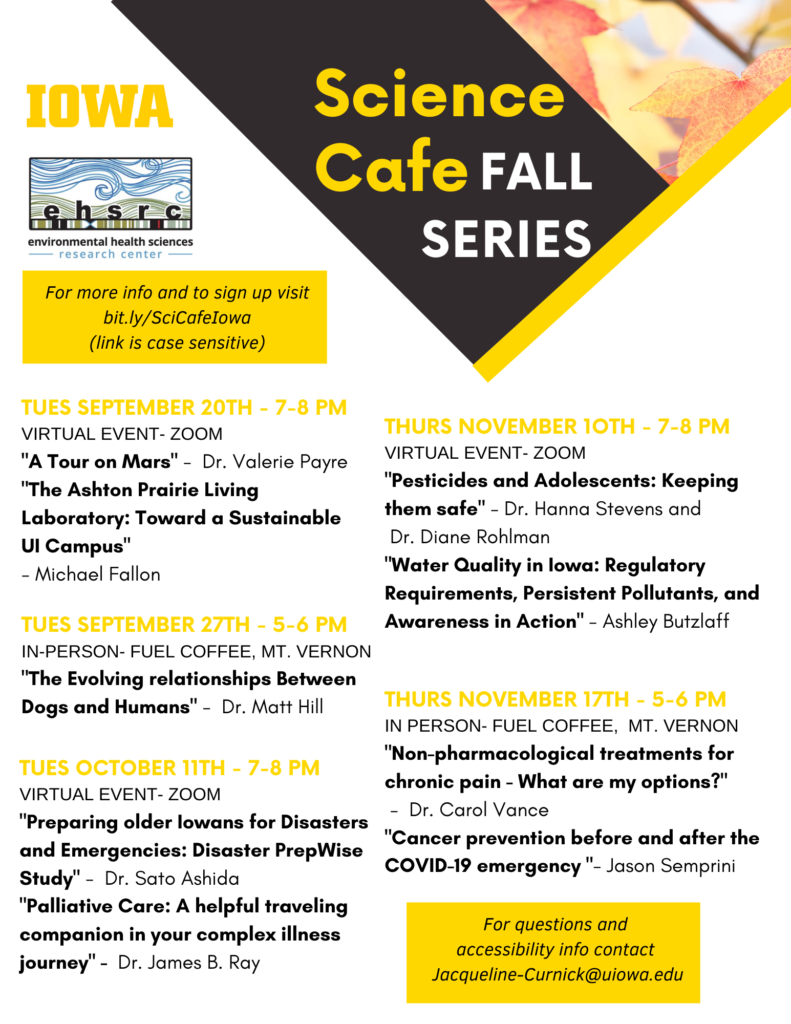The EHSRC is pleased to announce funding available of up to $10,000 available to facilitate community engaged and translational research related to environmental health.
Due date: June 1, 2023
Effective research translation and community engagement that result in new products or knowledge are iterative processes developed over time. The CERT fellowship funding will facilitate developing relationships and solving environmental health challenges in collaboration with audiences appropriate to the Fellow’s research, including community members, community-based organizations, clinicians, or others, to create new outputs of their research that are produced in collaboration with these stakeholders. Eligible applicants include faculty of any track, postdoctoral researchers, and graduate students completing a masters or doctoral thesis at the University of Iowa with interests in issues related to environmental contamination, environmental practices, community health and wellbeing, the effects of climate change on health, and community engaged research.
Fellows are strongly encouraged to utilize the resources of the EHSRC to enhance their work. This could include regular consultations with Community Engagement Core staff or use of the Integrated Health Sciences Facility Core (IHSFC) resources (e.g. Use of Clinical Research Unit Resources, Pulmonary Function Test Laboratory, Coordinator support, Advanced Pulmonary Physiomic Imaging Laboratory (APPIL))
Activities as part of the Fellowship must be relevant to the mission of the EHSRC and may include
- Relationship development, such as creating a stakeholder advisory board or working with community collaborators to identify research questions
- Conducting a needs assessment to identify community needs related to environmental health
- Conducting translational research to develop and implement clinical practices
- Collaboratively developing report-back materials to share environmental data with community members
Funding Available
Funds of up to $10,000 will be awarded directly to an investigator for a one-year period. Up to half of the proposed budget may be devoted to combined salary and fringe of the principal investigator. We anticipate making 1-2 awards to meritorious applications.
The application should include the following components
- Cover page that includes project title, name and contact information of principal investigators, and 250 word abstract (1 page)
- Project description/research strategy (up to 2 pages)
- The aims of the project and the research methodology (if appropriate)
- Anticipated outcomes and deliverables of the project.
- Describe how this project will engage with/utilize the resources of the EHSRC, such as the Community Engagement Core staff, the IHSFC, or others.
- Project justification (up to 2 pages)
- How will community engagement improve long-term or future research outcomes?
- Why are the community members identified in the proposal appropriate collaborators for this work?
- What unique elements of the collaboration will contribute to the project’s success
- What will be the next steps after the project is successfully completed?
- Budget and budget justification (up to 2 pages)
- Allowable expenses include salary and fringe (up to half of the proposed budget), travel expenses for investigators and community partners, compensation for community partners, and most expenses related to community events.
- CV or Biosketch for project PI(s) (up to 2 pages)
Email application as one document to Jacqueline-curnick@uiowa.edu
PDF of this RFP: CERT RFP 2023

 1994. He joined the UI faculty in 1998. He recently retired as a Professor from the University of Iowa’s College of Public Health with appointments in the Department of Occupational and Environmental Health and Department of Epidemiology.
1994. He joined the UI faculty in 1998. He recently retired as a Professor from the University of Iowa’s College of Public Health with appointments in the Department of Occupational and Environmental Health and Department of Epidemiology.